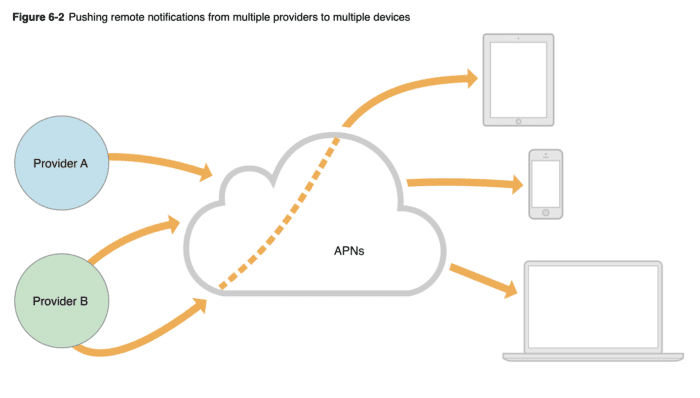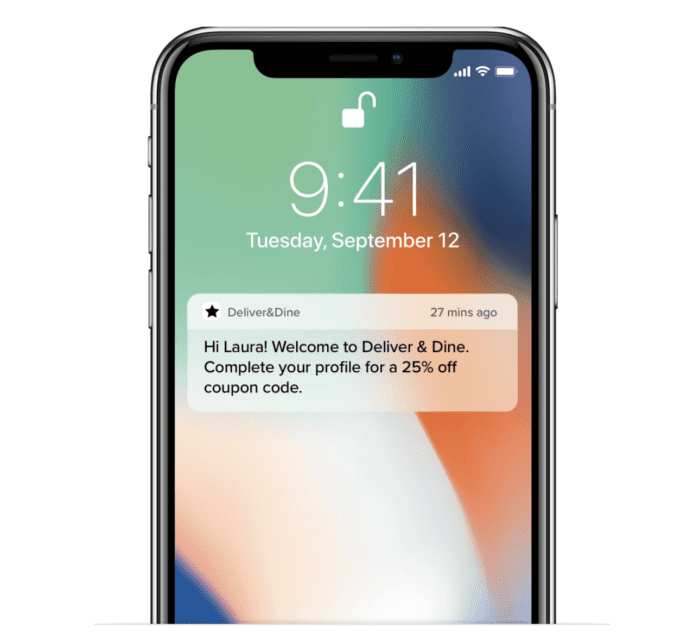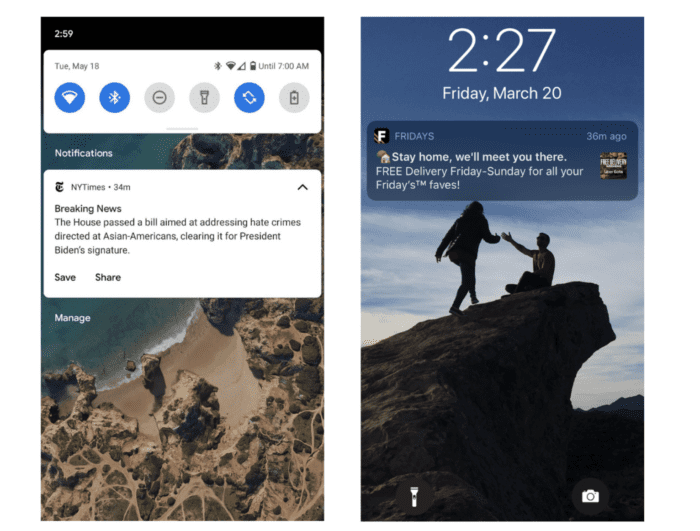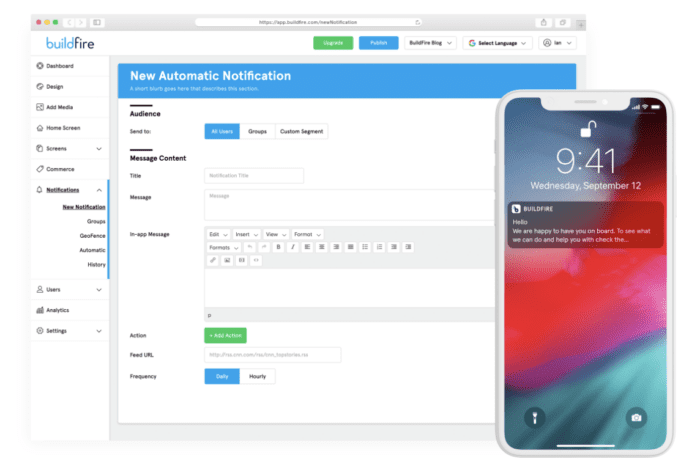Push notifications are an essential marketing tool for anyone with a mobile app. It’s the best way to connect with your users, delivering important and time-sensitive messages directly to their mobile devices.
You can use push notifications to drive engagement, increase app usage, influence conversions, and so much more. The possibilities are truly endless.
But there’s definitely a right and wrong way to use push notifications, which is why I created this guide. Continue below to learn more about how push notifications work, why you should use them, when to use push notifications, and how to leverage them effectively.
What is a Push Notification?
Let’s start with the basics and definitions before we move into the high-level strategies of push notifications.
Elements of a Push Notification
A push notification is a message that’s delivered directly to the home screen of a mobile device.
Push notifications are superior to email and other customer communication methods because of the delivery. Similar to an SMS text message, pushes go straight to the smartphone user. This almost guarantees that they’ll see it the next time they check their phone or tablet.
When users download an app, they’ll usually opt-in to these messages by default. But the user ultimately has more control over how each notification gets delivered.
While push messages are similar to texts, there are also some significant differences you should be aware of. When users open a push message, they’re brought straight to the app. They don’t land on a screen where they can read the rest of the message. This means that the message must be short, ensuring the users can read everything in its entirety directly from the lock screen.
That’s one of the reasons why push messages with fewer words have a higher click rate:

Unlike emails and texts, push notifications can be sent without the user sharing any contact information. Assuming the user has notifications enabled on their device, app publishers can send them at any time.
Push Notification Functionality: How it Works
There are lots of moving parts behind the scenes for a message to pop up on a user’s notification center.
A push notification service specific to each operating system is the first requirement. Then the app publisher needs to enable the app with each service. The push services ultimately give the publisher an API (application programming interface) as a communication method with each service. From here, the publisher must add an SDK to their app, which is a code library for each operating system.
Apple Push Notification service (APNs) is one example of an OS-specific service. Here’s a visual representation of how it works:

The process looks a bit different if you’re using APNs to send messages from multiple providers to multiple devices (like smartphones, tablets, and computers).

Beyond Apple, Google Firebase Cloud Messaging (FCM) is an example of a notification service for Android devices.
Once an app gets installed on a user’s device, incoming messages can finally get received.
Technical stuff aside, the basic concepts behind how this works from the publisher’s end is pretty straightforward. After you’ve been set up with a sending platform, it’s just a matter of drafting a new message, selecting the target audience, and sending the notification.
Why Do Apps Use Push Notifications?
There are countless benefits of push notifications. They increase open rates, keep users engaged, drive user retention, and ultimately enhance the user experience.
Think about the overwhelming amount of messages the average person sees on a daily basis. We’re constantly bombarded with TV ads, radio ads, billboards, social media ads, email ads—it’s never-ending. Most of those messages are of little interest to us.
But push messages are different. Users have already expressed interest by downloading a mobile application. This interest makes push notifications highly actionable.
That’s one of the reasons why push notifications perform better than email marketing.

I’d like to quickly clear one misconception. Push notifications are not for user acquisition. Remember, the user has already downloaded the app. So campaigns surrounding acquisition wouldn’t relate to push notifications. Read this guide if you’re trying to get more people to download your app.
The great part about push notifications is the ability to target different users based on interests and intent. You can leverage automation to send targeted messages to the right people at exactly the right time.
For example, a user who just downloaded your app shouldn’t get the same message as an existing user who hasn’t used your app in a month. The former needs a welcome message, and the latter needs a nudge to come back.

Here are some common types of push notifications for different apps:
- Promotional codes for discounts off next purchase
- Sports score updates
- Abandoned cart messages
- Send an alert for rideshare driver on the way
- Send an automated alert for food delivery arrival
- Triggered messages based on a location or action
- Reminder messages
- Breaking news updates
- Onboard a new user
As you can see, push notifications are really versatile. As an app owner, you’ll also have the ability to see data for your push messages. You can use that information to improve your campaigns moving forward. Tracking page visits to the promoted page, conversions, opens, and other KPIs will tell you which campaigns are working and which ones need improvement.
How Can Push Notification Campaigns Support My Business?
Now let’s dive into the nitty-gritty. Here’s where you’ll find the most important tips for high-converting push notifications.
Whether you’re targeting existing customers who are highly engaged or want to focus on users who are about to churn, the following strategies will help you nail every push notification campaign.
Provide Valuable & Relevant Content
If only two words cross your mind each time you craft a new message, make them “value” and “relevance.”
Is this message valuable? Is this message relevant? If the answer is no to either, then you need to rethink your intent and go back to the drawing board.
So many apps make the mistake of sending messages just for the sake of contacting the user. But if you’re not adding value or the message is irrelevant, mobile users will unsubscribe. We’ll cover this concept in greater detail later on.
Here are my favorite ways to ensure you’re sending the most relevant content to a user’s device:
- Send Targeted & Valuable Message Content — You should be segmenting users into different categories. Earlier we gave an example of sending a different message to new users than you would to an existing user. But you can break that down even further and send messages based on in-app actions, like a purchase or page visit.
- Use Location To Your Advantage — With GPS and geofencing enabled, you can send targeted messages to users based on their real-time location. For example, if a user walks or drives within three blocks of your restaurant during lunchtime, you can send them a promo code off their next lunch purchase. If you have an ecommerce app, users in southern California could get targeted promos about bathing suits, whereas a user in Colorado could get promos for winter coats.
If your messages aren’t relevant and they aren’t adding value to the end-user, they can end up doing more harm than good. But if you start each campaign with these concepts, your messages will convert on a higher level.
Test & Optimize For All Devices
You need to keep the user’s device and operating system in mind when you’re crafting push messages. There are differences between Android devices and Apple iPhones. There’s even a difference in the way Android users behave compared to iOS users.
For example, the text gets cut off on an iOS device around 170 characters. But for Android, you can have a 65-character title and 240-character description.
Aside from Android messages being longer, they also appear differently on the screen:

Even on the same OS, you’ll see subtle differences in push notifications between different software versions. The iOS 10.0 push notifications look different than the iOS 15.0 push notifications, even if they’re being sent to the exact same iPhone model.
Beyond the initial send, you need to be aware of differences between devices and OS for what happens after delivery.
With iOS notifications, the message disappears once the device is unlocked. But Android notifications remain in the notification center until an action is taken. Web push notifications in Chrome disappear when users leave that screen.
Understanding these subtleties between devices and OS is crucial for success. A message might not be performing well just because it’s too long for the device. It could have nothing to do with the intent of the campaign.
One way to combat this challenge is to segment users by device and OS. So your Android users will have different messages than iPhone users.
Incorporate Best Practices For Higher Success
As discussed, there are many different types of push notifications. Whether you’re sending abandoned cart messages, subscriptions, re-engagement messages, onboarding messages, social media messages, transactional pushes, or something else, you should keep the following tips in mind:
- Find the Right Send Frequency — Don’t send more than one push notification per week. Nearly half of all app users will opt out of messages if they get between two and five per week from the same app. So you need to be a bit more selective when you’re putting campaigns together. When in doubt, send at a lower frequency.
- Keep Word Count Low — Aside from the differences between devices and OS, it’s typically in your best interest to keep your messages short and sweet. Earlier, we saw the data showing that messages with fewer words have a higher click rate. So trim the fat from your campaigns and craft short messages, ideally in ten or fewer words.
- Personalize Messages For Higher Conversions — We’ve already discussed the importance of user segmentation. But you can take this one step further by personalizing campaigns with the user’s name, assuming you have that on record. Just look at the difference in opens between personalized content and non-personalized content:

Sending messages based on a user’s purchase history is an excellent way to do this.
For example, let’s say you have a restaurant delivery app. You can send a quick “reorder your favorite” message to users who placed an in-app order within the past week. If they ordered a large pepperoni pizza last Saturday, send them a personalized message this Saturday for a one-click pizza order.
Gain Results in Customer Engagement & Conversion Rates
Earlier I discussed the importance of relevance and value when deciding whether or not to send a push notification. But now I have two words to focus on for the results—engagement and conversions.
What are you trying to accomplish from your campaigns?
Your push marketing strategy should all boil down to higher conversion rates and increased customer engagement metrics.
That’s another reason why you should be tracking KPIs and other mobile marketing indicators. You’ll also want to monitor in-app user engagement and see if there’s a correlation between those numbers and your push campaigns.
Who is more likely to open and engage with a push message? An active user or inactive user? You might have an assumption, but the data will be the only way to truly know.
Always track the total number of notifications delivered. Then look at the number of clicks and the click rates for each individual campaign. You should also consider factors like the timing of your message or the day of the week.
Is it better to send notifications first thing in the morning so a user sees it when they wake up? Or do you get more clicks in the afternoon? Is there a difference between weekday pushes and weekend messages?
All of this needs to be taken into consideration and analyzed when you’re trying to optimize campaigns for engagement and conversions.
Dangers of Inappropriate Use of Push Notifications
App users are sensitive to mobile push notifications that are irrelevant and don’t add value. That’s why it’s so important to prioritize the user experience when you’re making new campaigns.
50% of people say they find push notifications annoying. Don’t burn your communication bridge with your users. Once they unsubscribe, there’s probably no chance they’ll opt-in again to pushes from your app.
You also need to ensure your campaign workflow is bulletproof. Some apps have accidentally sent inaccurate or inappropriate messages to an entire user base. That’s a quick way to hurt your brand reputation, and people could lose faith in your company.

Push notifications are great when used correctly. But they can do more harm than good if you’re not careful.
Don’t just send messages haphazardly for the sake of getting something out there. Each message must have a valid intent. Otherwise, users will unsubscribe, or worse—they could delete your app altogether.
Implementing Push Notifications For Your App
Ready to start sending push notifications to your app users? As previously mentioned, you need to set yourself up with a push notification service.
But if you’re using BuildFire to create your app, you can send and manage push messages directly from your admin dashboard.

As an app publisher, this will make your life ten times easier than going through a third-party.
In addition to crafting your messages directly from a simple dashboard, you can also enable automatic push sequences for different scenarios. BuildFire supports location-based messages with geofencing, and you’ll have full access to the message history and analytics.
Use BuildFire for activity-based notifications, drip notifications, messages for specific users, and custom user segments—the list goes on and on.
BuildFire is the easiest way to manage push notifications at every step of the user journey. Here are some helpful how-to articles from our knowledge base to get you started: